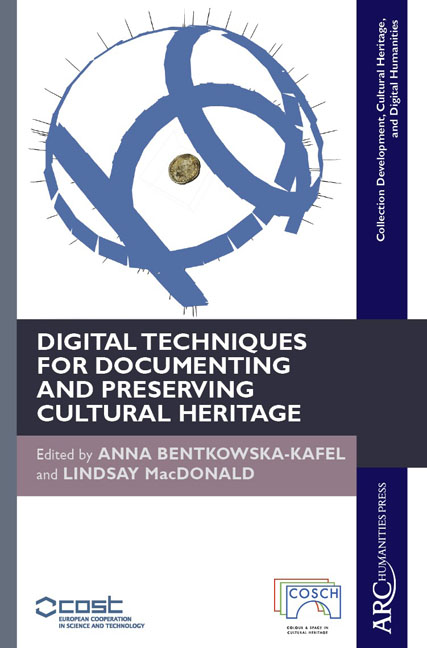Structure from Motion
Published online by Cambridge University Press: 26 January 2021
Summary
COSCH Case Studies that have employed this technology: Roman coins, Germolles, Kantharos, Bremen Cog
Definition
Structure from Motion (SfM) uses the principle that movement through a scene allows an understanding of the shape of objects within the scene in three dimensions, in the same way as walking through a room allows one to visualize the space and objects within it. In SfM the movement is represented by a series of systematic viewpoints; overlapping photographs taken from different locations around the object. This can be achieved from the ground in the field, in a photo studio, or from the air with a drone or other unmanned aerial vehicle (UAV).
Description
SfM is a method of photogrammetric recording. It is used for area-based recording and for object recording. A series of single images are photographed and the reconstruction of the 3D model uses similar steps to a photogrammetric workflow with orientation through image point comparison and bundle adjustment, measurement and analysis based on internal and external geometry, possibly using image masking, and output of a coloured point cloud or polygon mesh. Workflows include the combination of free software for photogrammetry, or licensed but affordable software, increasingly tailored for easy use. Whereas photogrammetry was previously used to measure a set of discrete points, typically using markers placed on objects within the scene, SfM extends the method (without the need for markers) by automatically finding feature correspondences and using dense matching techniques to reconstruct complete surfaces. The drawback is that where photographic coverage is poor the point clouds generated by SfM may be quite noisy and have “holes” in the surfaces represented by the point clouds, requiring subsequent smoothing and filling operations.
SfM can be used for the archaeological investigation of landscapes and built structures. The use of a kite or UAV can enable coverage of a large area in high resolution, allowing earthworks to be traced across the landscape. When used in conjunction with an archaeological excavation, its simplicity, low cost, high coverage and speed of recording, allows individual aspects of the 3D data to be analysed in ways that are simply not possible with 2D records. The amount of detail that can be captured makes this an ideal means of recording features that could be damaged or destroyed, such as fragile wooden objects, landscapes that are to be developed, or stratigraphic layers that must be removed.
- Type
- Chapter
- Information
- Publisher: Amsterdam University PressPrint publication year: 2018
- 1
- Cited by



